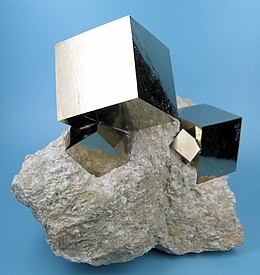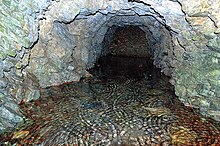Fool's gold
Pyrite's metallic luster and pale brass-yellow hue give it a superficial resemblance to gold, hence the well-known nickname of fool's gold. The color has also led to the nicknames brass, Brazzle, and Brazil, primarily used to refer to pyrite found in coal.
The name pyrite is derived from the Greek πυρίτης λίθος (pyritēs lithos), "stone or mineral which strikes fire", in turn from πῦρ (pyr), "fire". In ancient Roman times, this name was applied to several types of stone that would create sparks when struck against steel; Pliny the Elder described one of them as being brassy, almost certainly a reference to what we now call pyrite.
By Georgius Agricola's time, c. 1550, the term had become a generic term for all of the sulfide minerals.

Pyrite under normal and polarized light
Pyrite is usually found associated with other sulfides or oxides in quartz veins, sedimentary rock, and metamorphic rock, as well as in coal beds and as a replacement mineral in fossils, but has also been identified in the sclerites of scaly-foot gastropods.[12] Despite being nicknamed fool's gold, pyrite is sometimes found in association with small quantities of gold. A substantial proportion of the gold is "invisible gold" incorporated into the pyrite (see Carlin-type gold deposit). It has been suggested that the presence of both gold and arsenic is a case of coupled substitution but as of 1997, the chemical state of the gold remained controversial.
Uses
Pyrite enjoyed brief popularity in the 16th and 17th centuries as a source of ignition in early firearms, most notably the wheellock, where a sample of pyrite was placed against a circular file to strike the sparks needed to fire the gun.
Pyrite has been used since classical times to manufacture copperas (iron(II) sulfate). Iron pyrite was heaped up and allowed to weather (an example of an early form of heap leaching). The acidic runoff from the heap was then boiled with iron to produce iron sulfate. In the 15th century, new methods of such leaching began to replace the burning of sulfur as a source of sulfuric acid. By the 19th century, it had become the dominant method.
Pyrite remains in commercial use for the production of sulfur dioxide, for use in such applications as the paper industry, and in the manufacture of sulfuric acid. Thermal decomposition of pyrite into FeS (iron(II) sulfide) and elemental sulfur starts at 540 °C (1,004 °F); at around 700 °C (1,292 °F), pS2 is about 1 atm.
A newer commercial use for pyrite is the cathode material in Energizer brand non-rechargeable lithium batteries.
Pyrite is a semiconductor material with a band gap of 0.95 eV. Pure pyrite is naturally n-type, in both crystal and thin-film forms, potentially due to sulfur vacancies in the pyrite crystal structure acting as n-dopants.
During the early years of the 20th century, pyrite was used as a mineral detector in radio receivers, and is still used by crystal radio hobbyists. Until the vacuum tube matured, the crystal detector was the most sensitive and dependable detector available—with considerable variation between mineral types and even individual samples within a particular type of mineral. Pyrite detectors occupied a midway point between galena detectors and the more mechanically complicated perikon mineral pairs. Pyrite detectors can be as sensitive as a modern 1N34A germanium diode detector.
Pyrite has been proposed as an abundant, non-toxic, inexpensive material in low-cost photovoltaic solar panels. Synthetic iron sulfide was used with copper sulfide to create the photovoltaic material. More recent efforts are working toward thin-film solar cells made entirely of pyrite.
Pyrite is used to make marcasite jewelry. Marcasite jewelry, made from small faceted pieces of pyrite, often set in silver, was known since ancient times and was popular in the Victorian era. At the time when the term became common in jewelry making, "marcasite" referred to all iron sulfides including pyrite, and not to the orthorhombic FeS2 mineral marcasite which is lighter in color, brittle and chemically unstable, and thus not suitable for jewelry making. Marcasite jewelry does not actually contain the mineral marcasite. The specimens of pyrite, when it appears as good quality crystals, are used in decoration. They are also very popular in mineral collecting. Among the sites that provide the best specimens, highlights the exploited in Navajún, La Rioja (Spain).
China represents the main importing country with an import of around 376,000 tonnes, which resulted at 45% of total global imports. China is also the fastest growing in terms of the unroasted iron pyrites imports, with a CAGR of +27.8% from 2007 to 2016. In value terms, China ($47 million) constitutes the largest market for imported unroasted iron pyrites worldwide, making up 65% of global imports.
Formal oxidation states for pyrite, marcasite, and arsenopyrite
From the perspective of classical inorganic chemistry, which assigns formal oxidation states to each atom, pyrite is probably best described as Fe2+S22−. This formalism recognizes that the sulfur atoms in pyrite occur in pairs with clear S–S bonds. These persulfide units can be viewed as derived from hydrogen disulfide, H2S2. Thus pyrite would be more descriptively called iron persulfide, not iron disulfide. In contrast, molybdenite, MoS2, features isolated sulfide (S2−) centers and the oxidation state of molybdenum is Mo4+. The mineral arsenopyrite has the formula FeAsS. Whereas pyrite has S2 subunits, arsenopyrite has [AsS] units, formally derived from deprotonation of H2AsSH. Analysis of classical oxidation states would recommend the description of arsenopyrite as Fe3+[AsS]3−.
| Pyrite |
|---|
 | Add caption
|
Pyrite cubic crystals on marl from Navajún, La Rioja, Spain (size: 95 by 78 millimetres [3.7 by 3.1 in], 512 grams [18.1 oz]; main crystal: 31 millimetres [1.2 in] on edge) |
| General |
|---|
| Category | Sulfide mineral |
|---|
Formula
(repeating unit) | FeS2 |
|---|
| Strunz classification | 2.EB.05a |
|---|
| Dana classification | 2.12.1.1 |
|---|
| Crystal system | Isometric |
|---|
| Crystal class | Diploidal (m3)
H-M symbol: (2/m 3) |
|---|
| Space group | Pa3 |
|---|
| Unit cell | a = 5.417 Å, Z = 4 |
|---|
| Identification |
|---|
| Formula mass | 119.98 g/mol |
|---|
| Color | Pale brass-yellow reflective; tarnishes darker and iridescent |
|---|
| Crystal habit | Cubic, faces may be striated, but also frequently octahedral and pyritohedral. Often inter-grown, massive, radiated, granular, globular, and stalactitic. |
|---|
| Twinning | Penetration and contact twinning |
|---|
| Cleavage | Indistinct on {001}; partings on {011} and {111} |
|---|
| Fracture | Very uneven, sometimes conchoidal |
|---|
| Tenacity | Brittle |
|---|
| Mohs scale hardness | 6–6.5 |
|---|
| Luster | Metallic, glistening |
|---|
| Streak | Greenish-black to brownish-black |
|---|
| Diaphaneity | Opaque |
|---|
| Specific gravity | 4.95–5.10 |
|---|
| Density | 4.8–5 g/cm3 |
|---|
| Fusibility | 2.5–3 to a magnetic globule |
|---|
| Solubility | Insoluble in water |
|---|
| Other characteristics | paramagnetic |
|---|



















